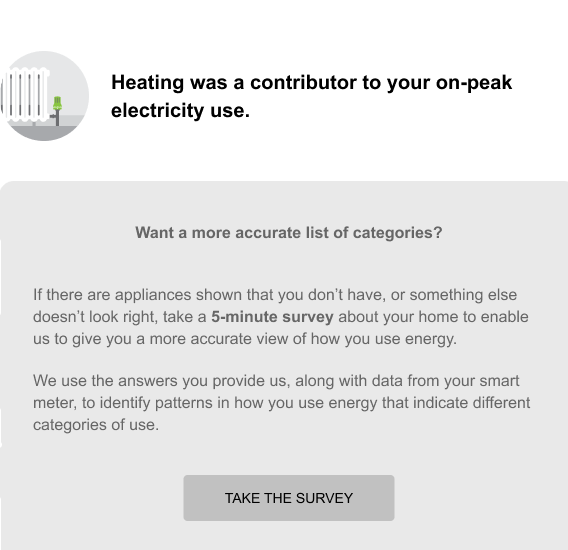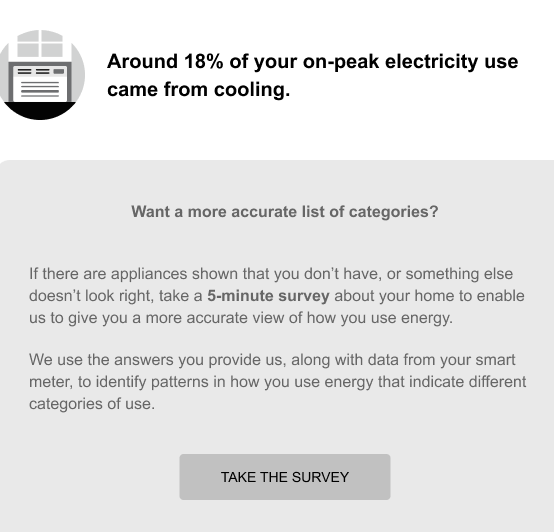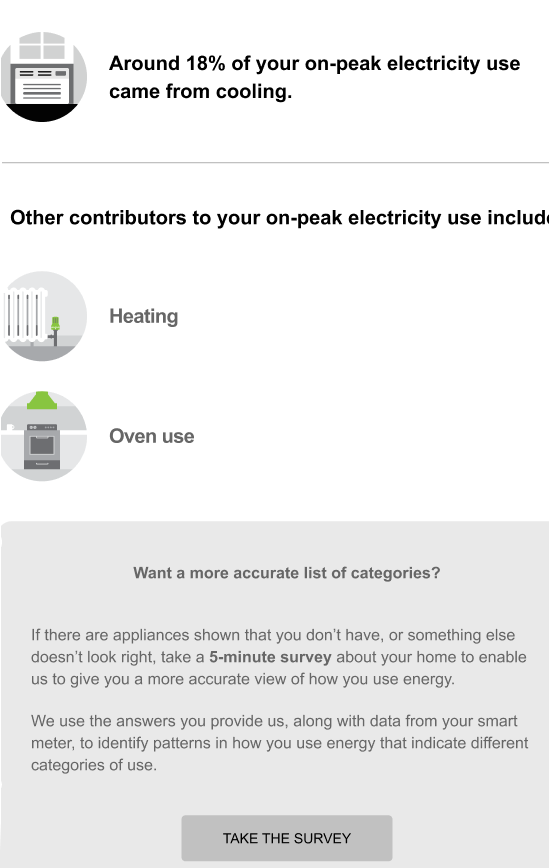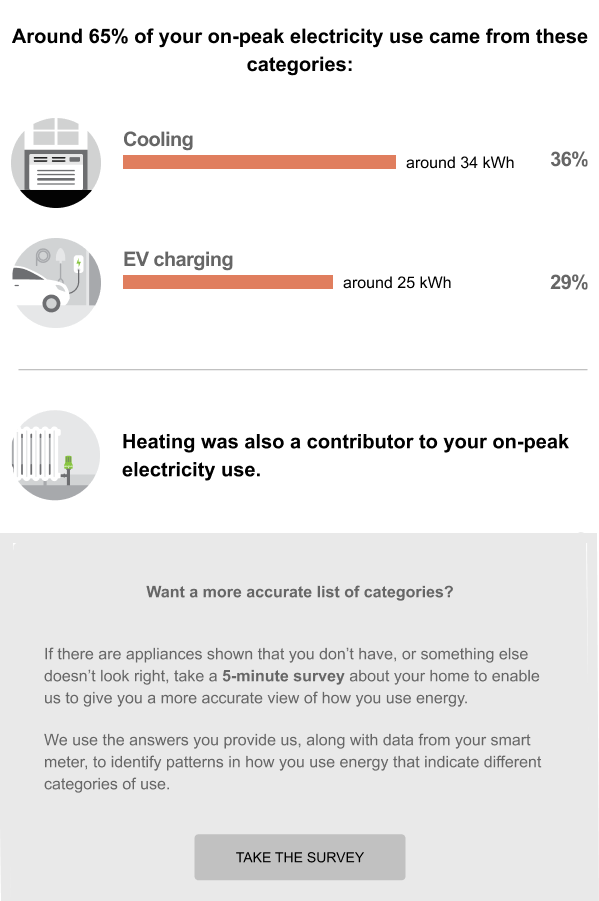Weekly Peak Period Disaggregation Module
This module provides the customer with insights about what appliances they use the most during peak hours each week as part of their TOU Weekly Coach email with peak period disaggregation. It highlights up to four customer end uses, and encourages the customer to improve their report insights by completing or updating their Home Energy Analysis. End uses are split into quantified and unqantified groups based primarily on the detail with which we can provide information about the appliance use.
Quantified End Uses: Quantified categories include end uses that our disaggregation algorithms are able to provide an accurate estimate of how much of the appliance a customer was using during peak hours, and therefore can be associated with a specific metric, such as kWh, percentage, or cost. Possible quantified end uses include:
- Cooling
- EV Charging
- Water Heating
- Dryer Use
A bar located next to the category indicates the percentage that category contributed to the customer's energy overall energy use.
Unquantified End Uses: The unquantefied category includes appliances that can be accurately detected if used during peak hours. Possible unquantified end uses include:
- Heating
- Oven use
Together, the qantified and unquantified groups provide the customer with a comprehensive picture of what contributes to their peak hour energy use. The goal of this module is to raise the customer's awareness of which of their appliances contribute the most to on-peak energy use so that they can take action to save energy during on-peak periods.
On this page:
Customer Requirements
|
Category |
Description |
|---|---|
|
Data Delivery Frequency |
Daily. |
|
Data Requirements |
Hourly or more granular AMI data. There are additional AMI data requirements to show advanced insights such as appliance-level disaggregation. Contact your Delivery Team for more information. |
|
Data History |
AMI data for at least one bill period. |
|
Data Coverage |
AMI data for all days in the week with peak hours. By default the number of allowable missed days is 0. |
Limitations
- Weekly Report with Weekly Peak Disaggregation only: This module is only available as part of the Weekly Coach Email with Weekly Peak Disaggregation.
- Hourly Disaggregation Service: Customers must be eligible for the Hourly Disaggregation service in order to receive the Weekly Coach Email with Weekly Peak Disaggregation and Post-Bill Report email.
- End Use Categories: End use categories included in this module are limited to cooling, EV charging, water heating, dryer use, heating, and oven use.
- Usage Only: Only usage is supported in the disaggregation breakdown.
- Seasonal Transition: Costs cannot be calculated for this module if the seasonal transition occurs within the module look back period.
User Experience
Design
This image shows an example of the Weekly Peak Period Disaggregation module for a customer with two quantified and two unquantified end uses who has not yet started or has not completed, the Home Energy Analysis.

User Experience Variations
This section discusses the user experience variations in the Weekly Peak Period Disaggregation module.
Header
The header varies by the number of quantified and unquantified end uses:
| Data States | Number of Appliances | Cost Copy | Usage Copy |
| Quantified Header | 2+ | Around X% of your on-peak energy use came from these categories: | |
| 1 | Around x% of your on-peak energy use came from <use category>. | ||
| Unquantified Header | 0 | Not applicable. Section is omitted. | |
| 2+ | Other contributors to your on-peak energy use include: | ||
| 2+ with quantified section omitted | Contributors to your on-peak energy use include: | ||
| 1 | <category> was a contributor to your energy use. | ||
| 0 | Not applicable. Section is omitted. | ||
Call-to-Action
The call-to-action section varies depending on whether the customer has completed the Home Energy Analysis.
| Home Energy Analysis Status | Heading | Body Text | Home Energy Analysis Link or Button |
| Incomplete | Want a more accurate list of categories? | If there are appliances shown that you don’t have, or something else doesn’t look right, take a 5-minute survey about your home to enable us to give you a more accurate view of how you use energy. We use the answers you provide us, along with data from your smart meter, to identify patterns in how you use energy that indicate different categories of use. | Button |
| Complete | How do we know how you use energy? | Thanks to data from your smart meter, we can identify patterns in your electricity use that give us an idea of what appliances are using electricity in your home. We can match those end uses to different times of day to determine what appliances you use during peak hours. To get the most accurate view of your appliance use, make sure your home profile is up-to-date. | Link |
Zero Quantified Use Categories and One or More Unquantified Use Categories
If there are no quantified use cases, the quantified section is omitted. The uquantified header is omitted when there is only one unquantified category. The text next to the unquantified icon indicates that the use category contributed to their on-peak usage. The call-to-action section varies depending on whether the customer has completed their Home Energy Analysis.

One Quantified Use Category and Zero Unquantified Use Categories
If there is only one quantified category, the quantified section header is omitted. Text indicating what percent of the on-peak electricity usage came from the use category is located next to the use case icon. The call-to-action section varies depending on whether the customer has completed their Home Energy Analysis. The unquantified section is omitted.

One Quantified Use Category and One Unquantified Use Categories
If there is only one quantified and one unquantified category, the headings are omitted. Text next to the quantified icon indicates what percent of the on-peak electricity usage came from the use category. Text next to the unquantified category indicates that it contribute to their on-peak use. The call-to-action section varies depending on whether the customer has completed their Home Energy Analysis.

One Quantified Use Category and Two or More Unquantified Use Categories
The quantified section omits the use categories heading. Text next to the quantified use icon indicates what percent of the on-peak electricity usage came from the use category. The unquantified header indicated that the listed categories were also contributors to on-peak usage. The names of the unquantified use categories are located next to the unquantified use icons. The call-to-action section varies depending on whether the customer has completed their Home Energy Analysis.

Two or More Quantified Use Categories and One Unquantified Use Category
The quantified section includes the quantified header and quantified end use category breakdown. The unquantified use header is omitted from the unquantified use section. Text next to the unquantified category indicates that it contribute to their on-peak use. The call-to-action section varies depending on whether the customer has completed their Home Energy Analysis.

Zero Quantified Use Categories and Two or More Unquantified Use Categories
The quantified section is omitted. The unquantified use section includes a header. The names of the unquantified end use category is included next to the icon. The call-to-action section varies depending on whether the customer has completed their Home Energy Analysis.

Zero Quantified Use Categories and Zero Unquantified Use Categories
The module is not included in the report.
Data Overlapping the Seasonal Transition Date
Costs cannot be calculated for this module if the seasonal transition occurs within the module look back period. The behavior of the module is impacted by whether or not the peak hours data has changed.
Peak hours have changed: If peak hours changed at the season transition, and the look-back period for a given module overlaps the season transition date, then the module fails and the individual module is not included in the Time of Use Coach email type. The report will still be sent with the remaining modules.
Peak hours have not changed: If the customer's peak hours have not changed, one the following variations occurs:
- If peak hours have not changed in a period that overlaps the seasonal transition, the seasonal transition module is shown in usage form.
- If peak hours have not changed in a period that overlaps the seasonal transition, and non-peak data for other data changing modules in the report have changed during the season transition date, then all of the report modules are shown in usage form. Costs are not calculated or shown.
Configuration Options
For each element listed in the table, indicate the desired configuration in the Input Value column. If you do not provide an input for optional configurations, the default will be used.
| Configuration Option | Input Value |
|---|---|
|
Allowable number of missed days of scored AMI data By default, the number of allowable missed days of scored AMI data is 0. |
Optional Choose one of the following: Use the default. Work with your Delivery Team to customize the number of allowable missed days of scored AMI data. |
|
Exclude disaggregation categories shown The default is cooling, EV charging, water heating, dryer use, heating, and oven use.. Any of these can be excluded by the utility. Note: This configuration is shared with the Post-Bill Report. |
Optional Choose one of the following: Use the default. Work with your Delivery Team to exclude disaggregation categories from the module. |
To see how this module fits into the overall user experience, see BLS TOU Coach Customer Experience.